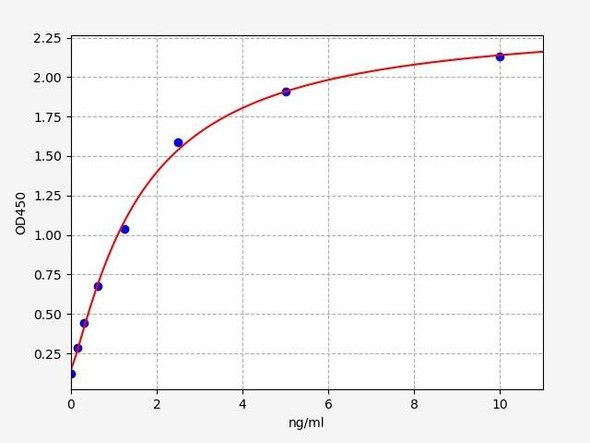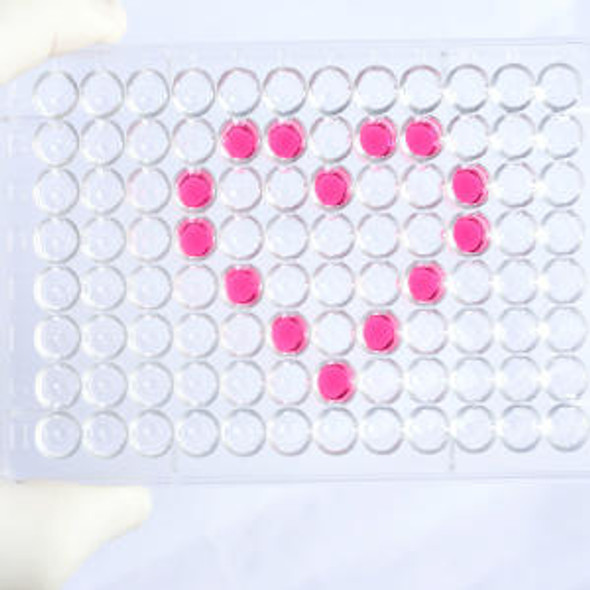Human Metabolism ELISA Kits
Human HSP-90 (Heat Shock Protein 90) ELISA Kit (HUES02816)
- SKU:
- HUES02816
- Product Type:
- ELISA Kit
- Size:
- 96 Assays
- Uniprot:
- P08238
- Sensitivity:
- 1.88ng/mL
- Range:
- 3.13-200ng/mL
- ELISA Type:
- Sandwich
- Synonyms:
- Hsp90
- Reactivity:
- Human
- Sample Type:
- Serum, plasma and other biological fluids
- Research Area:
- Metabolism
Description
| Assay type: | Sandwich |
| Format: | 96T |
| Assay time: | 4.5h |
| Reactivity: | Human |
| Detection Method: | Colormetric |
| Detection Range: | 3.13-200 ng/mL |
| Sensitivity: | 1.88 ng/mL |
| Sample Volume Required Per Well: | 100µL |
| Sample Type: | Serum, plasma and other biological fluids |
| Specificity: | This kit recognizes Human HSP-90 in samples. No significant cross-reactivity or interference between Human HSP-90 and analogues was observed. |
This ELISA kit uses Sandwich-ELISA as the method. The micro ELISA plate provided in this kit has been pre-coated with an antibody specific to Human HSP-90. Standards or samples are added to the appropriate micro ELISA plate wells and combined with the specific antibody. Then a biotinylated detection antibody specific for Human HSP-90 and Avidin-Horseradish Peroxidase (HRP) conjugate are added to each micro plate well successively and incubated. Free components are washed away. The substrate solution is added to each well. Only those wells that contain Human HSP-90, biotinylated detection antibody and Avidin-HRP conjugate will appear blue in color. The enzyme-substrate reaction is terminated by adding Stop Solution and the color turns yellow. The optical density (OD) is measured spectrophotometrically at a wavelength of 450 nm ± 2 nm. The OD value is proportional to the concentration of Human HSP-90. The concentration of Human HSP-90 in samples can be calculated by comparing the OD of the samples to the standard curve.
| UniProt Protein Function: | HSP90B: Molecular chaperone that promotes the maturation, structural maintenance and proper regulation of specific target proteins involved for instance in cell cycle control and signal transduction. Undergoes a functional cycle that is linked to its ATPase activity. This cycle probably induces conformational changes in the client proteins, thereby causing their activation. Interacts dynamically with various co-chaperones that modulate its substrate recognition, ATPase cycle and chaperone function. Homodimer. Interacts with p53/TP53. Forms a complex with CDK6 and Hsp90/HSP90AB1. Interacts with UNC45A. Binding to UNC45A involves 2 UNC45A monomers per HSP90AB1 dimer. Interacts with CHORDC1 and DNAJC7. Interacts with FKBP4. Belongs to the heat shock protein 90 family. |
| UniProt Protein Details: | Protein type:Heat shock protein; Chaperone Chromosomal Location of Human Ortholog: 6p12 Cellular Component: apical plasma membrane; basolateral plasma membrane; brush border membrane; cell surface; cytoplasm; cytosol; inclusion body; melanosome; membrane; mitochondrion; nucleoplasm; signalosome Molecular Function:ATP binding; dATP binding; double-stranded RNA binding; GTP binding; histone deacetylase binding; kinase binding; nitric-oxide synthase regulator activity; protein binding; protein kinase binding; sulfonylurea receptor binding; TPR domain binding; unfolded protein binding Biological Process: axon guidance; innate immune response; negative regulation of neuron apoptosis; negative regulation of proteasomal ubiquitin-dependent protein catabolic process; placenta development; positive regulation of cell size; positive regulation of nitric oxide biosynthetic process; positive regulation of protein binding; positive regulation of protein import into nucleus, translocation; protein folding; regulation of protein ubiquitination; response to salt stress; response to unfolded protein; virion attachment to host cell surface receptor |
| NCBI Summary: | This gene encodes a member of the heat shock protein 90 family; these proteins are involved in signal transduction, protein folding and degradation and morphological evolution. This gene encodes the constitutive form of the cytosolic 90 kDa heat-shock protein and is thought to play a role in gastric apoptosis and inflammation. Alternative splicing results in multiple transcript variants. Pseudogenes have been identified on multiple chromosomes. [provided by RefSeq, Dec 2012] |
| UniProt Code: | P08238 |
| NCBI GenInfo Identifier: | 17865718 |
| NCBI Gene ID: | 3326 |
| NCBI Accession: | P08238. 4 |
| UniProt Secondary Accession: | P08238,Q5T9W7, Q9NQW0, Q9NTK6, B2R5P0, |
| UniProt Related Accession: | P08238 |
| Molecular Weight: | 83,264 Da |
| NCBI Full Name: | Heat shock protein HSP 90-beta |
| NCBI Synonym Full Names: | heat shock protein 90kDa alpha family class B member 1 |
| NCBI Official Symbol: | HSP90AB1 |
| NCBI Official Synonym Symbols: | HSP84; HSPC2; HSPCB; D6S182; HSP90B |
| NCBI Protein Information: | heat shock protein HSP 90-beta |
| UniProt Protein Name: | Heat shock protein HSP 90-beta |
| UniProt Synonym Protein Names: | Heat shock 84 kDa; HSP 84; HSP84 |
| Protein Family: | Heat shock protein |
| UniProt Gene Name: | HSP90AB1 |
| UniProt Entry Name: | HS90B_HUMAN |
As the OD values of the standard curve may vary according to the conditions of the actual assay performance (e. g. operator, pipetting technique, washing technique or temperature effects), the operator should establish a standard curve for each test. Typical standard curve and data is provided below for reference only.
| Concentration (ng/mL) | O.D | Average | Corrected |
| 200 | 2.14 2.186 | 2.163 | 2.096 |
| 100 | 1.467 1.477 | 1.472 | 1.405 |
| 50 | 0.839 0.837 | 0.838 | 0.771 |
| 25 | 0.401 0.423 | 0.412 | 0.345 |
| 12.5 | 0.232 0.206 | 0.219 | 0.152 |
| 6.25 | 0.154 0.152 | 0.153 | 0.086 |
| 3.13 | 0.104 0.122 | 0.113 | 0.046 |
| 0 | 0.067 0.067 | 0.067 | -- |
Precision
Intra-assay Precision (Precision within an assay): 3 samples with low, mid range and high level Human HSP-90 were tested 20 times on one plate, respectively.
Inter-assay Precision (Precision between assays): 3 samples with low, mid range and high level Human HSP-90 were tested on 3 different plates, 20 replicates in each plate.
| Intra-assay Precision | Inter-assay Precision | |||||
| Sample | 1 | 2 | 3 | 1 | 2 | 3 |
| n | 20 | 20 | 20 | 20 | 20 | 20 |
| Mean (ng/mL) | 9.80 | 31.50 | 90.70 | 10.10 | 31.70 | 90.80 |
| Standard deviation | 0.50 | 1.60 | 3.40 | 0.70 | 1.70 | 4.20 |
| C V (%) | 5.10 | 5.08 | 3.75 | 6.93 | 5.36 | 4.63 |
Recovery
The recovery of Human HSP-90 spiked at three different levels in samples throughout the range of the assay was evaluated in various matrices.
| Sample Type | Range (%) | Average Recovery (%) |
| Serum (n=5) | 90-105 | 97 |
| EDTA plasma (n=5) | 84-97 | 91 |
| Cell culture media (n=5) | 91-106 | 96 |
Linearity
Samples were spiked with high concentrations of Human HSP-90 and diluted with Reference Standard & Sample Diluent to produce samples with values within the range of the assay.
| Serum (n=5) | EDTA plasma (n=5) | Cell culture media (n=5) | ||
| 1:2 | Range (%) | 89-104 | 85-96 | 87-100 |
| Average (%) | 97 | 91 | 93 | |
| 1:4 | Range (%) | 98-112 | 83-95 | 95-108 |
| Average (%) | 106 | 88 | 100 | |
| 1:8 | Range (%) | 101-115 | 83-95 | 97-113 |
| Average (%) | 107 | 88 | 105 | |
| 1:16 | Range (%) | 97-109 | 82-95 | 97-112 |
| Average (%) | 103 | 89 | 103 |
An unopened kit can be stored at 4°C for 1 month. If the kit is not used within 1 month, store the items separately according to the following conditions once the kit is received.
| Item | Specifications | Storage |
| Micro ELISA Plate(Dismountable) | 8 wells ×12 strips | -20°C, 6 months |
| Reference Standard | 2 vials | |
| Concentrated Biotinylated Detection Ab (100×) | 1 vial, 120 µL | |
| Concentrated HRP Conjugate (100×) | 1 vial, 120 µL | -20°C(shading light), 6 months |
| Reference Standard & Sample Diluent | 1 vial, 20 mL | 4°C, 6 months |
| Biotinylated Detection Ab Diluent | 1 vial, 14 mL | |
| HRP Conjugate Diluent | 1 vial, 14 mL | |
| Concentrated Wash Buffer (25×) | 1 vial, 30 mL | |
| Substrate Reagent | 1 vial, 10 mL | 4°C(shading light) |
| Stop Solution | 1 vial, 10 mL | 4°C |
| Plate Sealer | 5 pieces | |
| Product Description | 1 copy | |
| Certificate of Analysis | 1 copy |
- Set standard, test sample and control (zero) wells on the pre-coated plate and record theirpositions. It is recommended to measure each standard and sample in duplicate. Note: addall solutions to the bottom of the plate wells while avoiding contact with the well walls. Ensuresolutions do not foam when adding to the wells.
- Aliquot 100µl of standard solutions into the standard wells.
- Add 100µl of Sample / Standard dilution buffer into the control (zero) well.
- Add 100µl of properly diluted sample (serum, plasma, tissue homogenates and otherbiological fluids) into test sample wells.
- Cover the plate with the sealer provided in the kit and incubate for 90 min at 37°C.
- Aspirate the liquid from each well, do not wash. Immediately add 100µL of BiotinylatedDetection Ab working solution to each well. Cover the plate with a plate seal and gently mix. Incubate for 1 hour at 37°C.
- Aspirate or decant the solution from the plate and add 350µL of wash buffer to each welland incubate for 1-2 minutes at room temperature. Aspirate the solution from each well andclap the plate on absorbent filter paper to dry. Repeat this process 3 times. Note: a microplatewasher can be used in this step and other wash steps.
- Add 100µL of HRP Conjugate working solution to each well. Cover with a plate seal andincubate for 30 min at 37°C.
- Aspirate or decant the solution from each well. Repeat the wash process for five times asconducted in step 7.
- Add 90µL of Substrate Reagent to each well. Cover with a new plate seal and incubate forapproximately 15 min at 37°C. Protect the plate from light. Note: the reaction time can beshortened or extended according to the actual color change, but not by more than 30min.
- Add 50 µL of Stop Solution to each well. Note: Adding the stop solution should be done inthe same order as the substrate solution.
- Determine the optical density (OD value) of each well immediately with a microplate readerset at 450 nm.






